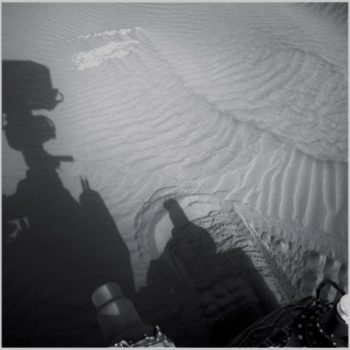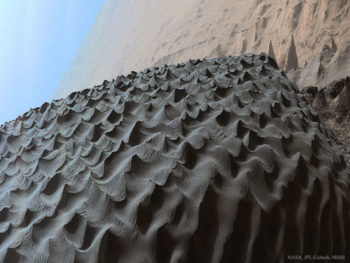
Self-portrait of NASA’s Curiosity Mars rover from January 19, 2016 shows the vehicle at “Namib Dune,” where the rover’s activities included scuffing into the dune with a wheel and scooping samples of sand for laboratory analysis.
Credit: NASA/JPL-Caltech/MSSS
NASA’s Curiosity Mars rover is now performing Sol 2209 duties. Engineering trouble-shooting continues regarding the robot’s memory that prevents the machine from sending much of gathered science and engineering data.
Recapping the rover’s earlier dune exploration, Catherine O’Connell, a planetary geologist at the University of New Brunswick, Fredericton, New Brunswick in Canada, reports: As Curiosity continues on its journey up Mount Sharp (the mound in the center of Gale crater), rocks encountered by the robot contain evidence for changing environmental conditions.
The fine-grained mudstones of the Murray formation show that lakes were present in the past, whilst the sandstones of the Stimson formation are evidence for ancient dune fields.

Curiosity’s traverse (white line) and two-phase investigation of the Bagnold Dunes. Inset shows the study location (white rectangle) within Gale crater.
Credit: after Lapotre and Rampe, 2018
Active dune system
“During 2015-2017, we crossed the Bagnold dune field, a (22-mile) 35-kilometer long by 1-2 kilometers wide dune field that wraps around the northwest side of Mount Sharp. This was the first time that scientists have explored an active dune system on another planet,” O’Connell says.
In the Martian fall/winter, the rover investigated two “barchans” dunes, O’Connell adds. Barchan dunes are crescent shaped and are formed by winds blowing in one direction, and when sediment supply is limited.
Blowing winds
Later on, during the Martian summer, Curiosity examined a linear dune. Linear dunes are formed by winds blowing in two directions, with more abundant sediment supply, and can be very long (on Earth, they can reach 160 miles in length e.g., Namib Sand Sea, Namibia).
“Curiosity lived up to her official name ‘Mars Science Laboratory’ for both parts of the campaign, utilizing almost every scientific instrument on board, plus the engineering cameras (Navcam and Hazcam) to collect observations and measurements,” O’Connell points out.
Grain size, motion
As the rover traversed the dune field and at each stop, scientists observed the physical properties of the sand dunes, such as grain size, rates of grain motion, and the overall bedform morphologies, using the robot’s Mars Hand Lens Imager (MAHLI), the Chemistry and Camera (ChemCam) instrument, Mars Descent Imager (MARDI) as well as the Mastcam, Navcam, and the Rover Environmental Monitoring Station (REMS).
“We observed differences in wind activity levels, with lower wind and less movement of sand during the fall/winter than during the summer,” O’Connell says.

Mosaic of Mast Camera (Mastcam) images showing the downwind face (stoss) of Namib Dune, acquired on sol 1196 during Phase 1 of the science campaign. Credit: NASA/JPL-Caltech/MSSS
Dust content
Dust content — indicated by sulphur, chlorine and zinc levels – were measured by the robot’s Alpha Particle X-Ray Spectrometer (APXS). Higher concentrations mean higher dust content, indicating that observed activity levels were higher in the linear dunes which were investigated during the summer (higher winds, less dust settling) and lower in the barchan dunes, which were investigated during the fall/winter.
Also determined were chemical composition, mineralogy and volatile content of sands using APXS, ChemCam, the Chemistry & Mineralogy X-Ray Diffraction/X-Ray Fluorescence Instrument (CheMin), Dynamic Albedo of Neutrons (DAN) instrument and the Sample Analysis at Mars (SAM) Instrument Suite.
“My role as a member of the APXS operations team involved evaluating the composition of samples analyzed, comparing between the barchan and linear dunes, as well as sands previously analyzed by the Opportunity rover (at Meridiani Planum) and Spirit (at Gusev Crater),” O’Connell adds.
Subtle variations
The basaltic Bagnold sands show subtle variations in mineralogy and chemistry, both between the barchan and linear dunes, but also depending on location within a dune.
For example, ripple crests were often more coarse-grained and enriched in magnesium and nickel, whilst off-crest sands within the linear dunes were enriched in chromium. These variations may reflect sorting processes, or minor enrichments from local bedrock sources.
“Our journey through the Bagnold Dunes,” O’Connell concludes, “has helped advanced our understanding of how winds shape modern Martian landscapes, and the properties of windblown materials, in the form of both the active Bagnold dunes and in ancient Martian dunes now preserved as rock in units such as the Stimson formation at Gale crater.”
For more information, go to this October 17, 2018 scientific paper, “Seeing Mars in a Grain of Sand” by Lapotre, M. G. A. in American Geophysical Union’s Eos publication:



